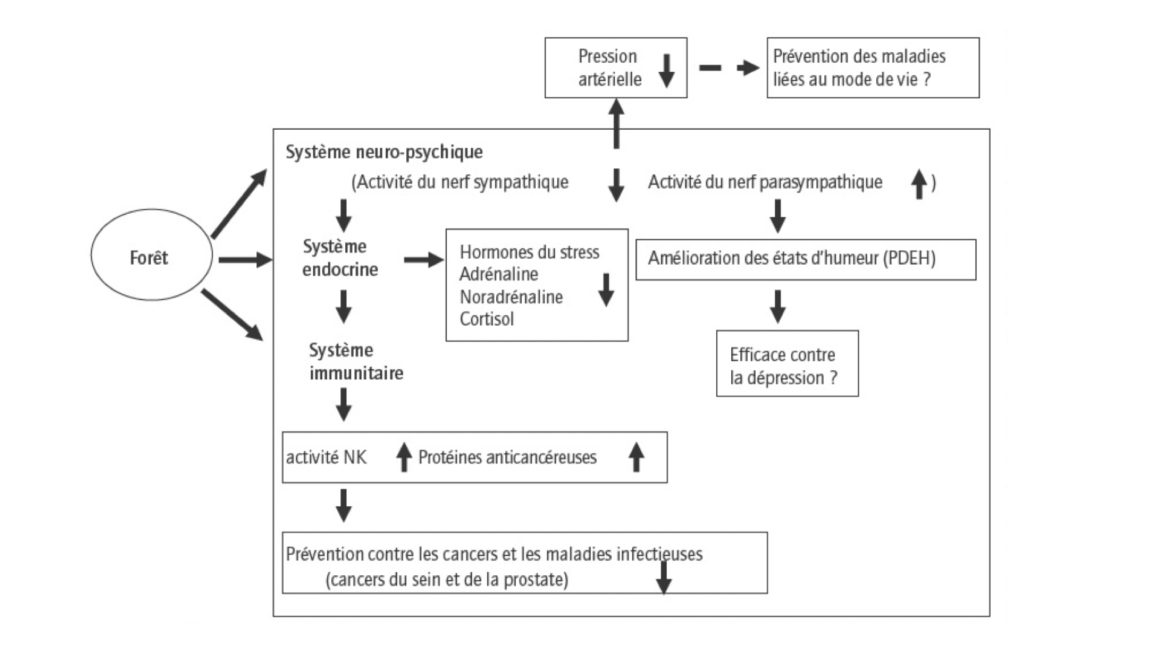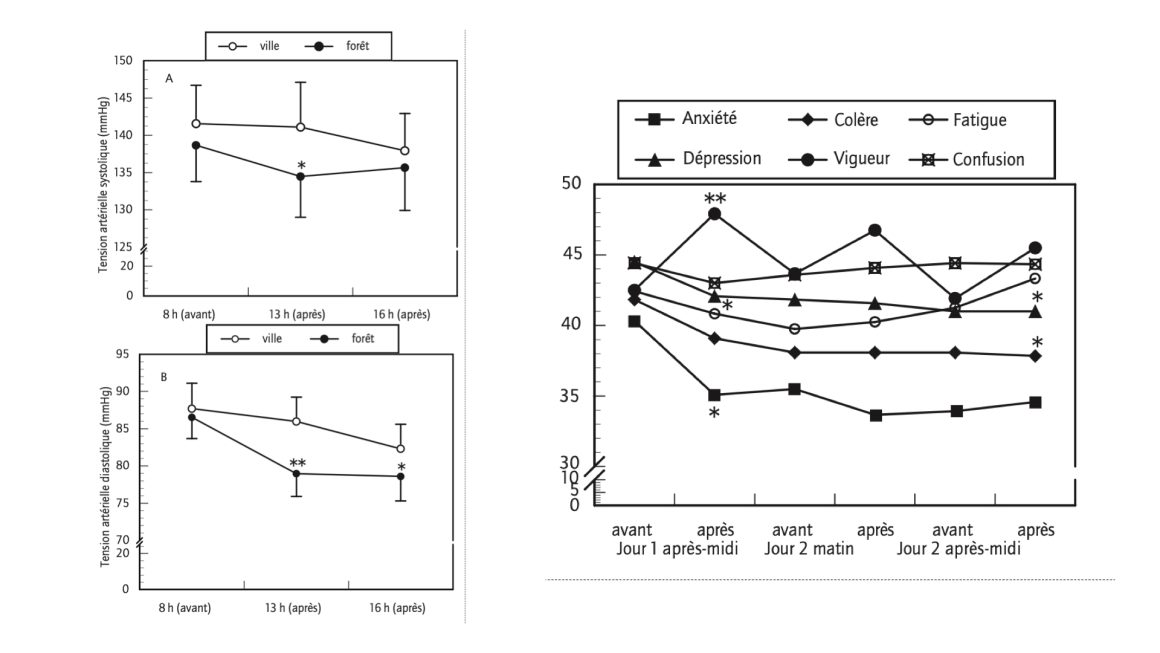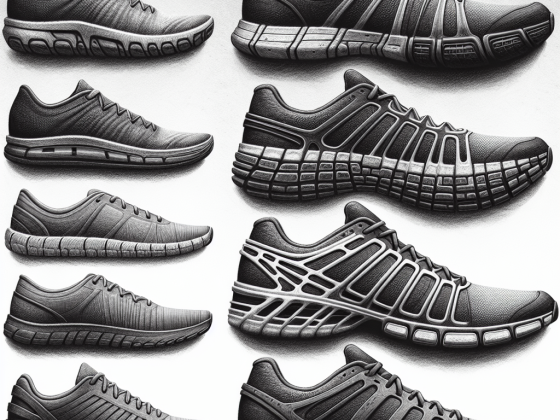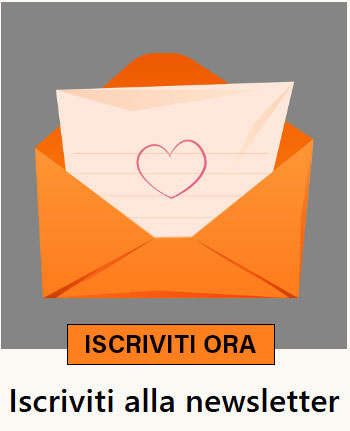Da secoli, l’umanità ha trovato conforto e ispirazione negli ambienti forestali. Le foreste non sono solo rifugi di bellezza naturale, ma veri e propri polmoni del nostro pianeta e della nostra anima. Recentemente, questa antica connessione ha trovato solide basi scientifiche ( “Effets des forêts et des bains de forêt (shinrin-yoku) sur la santé humaine : une revue de la littérature” ) : dal 2004, il Giappone ha intrapreso ricerche pionieristiche che hanno dato vita a una nuova disciplina, la Medicina Forestale.
Questa scienza interdisciplinare unisce medicina alternativa, medicina ambientale e medicina preventiva per studiare gli effetti degli ambienti forestali sulla salute umana. I risultati non solo confermano ciò che molti di noi percepiscono intuitivamente, ma rivelano benefici sorprendenti per il corpo e la mente:
1. Supporto al Sistema Immunitario
Gli studi dimostrano che trascorrere del tempo in ambienti forestali aumenta l’attività delle cellule natural killer (NK), che giocano un ruolo cruciale nella lotta contro le infezioni e i tumori. È stato osservato un incremento delle proteine antitumorali intracellulari, suggerendo un potenziale effetto preventivo contro il cancro.
2. Riduzione dello Stres
Camminare nella natura contribuisce a ridurre la pressione sanguigna, la frequenza cardiaca e i livelli di ormoni dello stress come adrenalina, noradrenalina e cortisolo. In altre parole, immergersi in una foresta può portare calma e rilassamento profondo.
3. Equilibrio del Sistema Nervoso
Gli ambienti forestali stimolano i nervi parasimpatici, responsabili del rilassamento, mentre riducono l’attività dei nervi simpatici, associati alla risposta “combatti o fuggi”. Questo riequilibrio favorisce una migliore gestione dello stress quotidiano.
4. Miglioramento della Salute Metabolica
Sono stati registrati aumenti significativi nei livelli di adiponectina e deidroepiandrosterone solfato, due biomarcatori associati alla salute cardiovascolare, al metabolismo e alla longevità.
5. Effetti Psicologici Positivi
Il test Profile of Mood States (POMS) ha evidenziato che trascorrere tempo nelle foreste riduce ansia, depressione, rabbia, stanchezza e confusione. Al contempo, aumenta il vigore e la vitalità, migliorando complessivamente l’umore e il benessere psicologico.
Viviamo in un mondo dominato dalla frenesia e dalla tecnologia, dove le malattie legate allo stile di vita, come stress cronico, ipertensione, obesità e depressione, sono sempre più diffuse.
Le foreste agiscono come spazi di guarigione, non solo per il corpo, ma anche per la mente.
Attraverso il “bagno di foresta” o shinrin-yoku, pratica giapponese che consiste nel camminare lentamente tra gli alberi, possiamo riattivare il nostro equilibrio psicofisico.


Come possiamo Iniziare?
Ecco alcuni consigli per integrare la natura nella tua vita:
• Visita regolarmente le aree verdi vicino a te: parchi, riserve naturali o boschi.
• Cammina lentamente e consapevolmente: lascia a casa il telefono e concentrati su suoni, odori e panorami.
• Respira profondamente: l’aria fresca e pulita delle foreste è ricca di fitoncidi, sostanze chimiche naturali che stimolano il sistema immunitario.
• Coltiva una connessione emotiva: concediti momenti di silenzio per riflettere e lasciarti ispirare dall’ambiente circostante.
La Medicina Forestale ci ricorda una verità semplice ma potente: il nostro benessere è profondamente legato alla natura.
Le foreste non sono solo risorse ecologiche, ma veri e propri alleati per la salute fisica e mentale. In un’epoca in cui cerchiamo soluzioni per vivere meglio, forse la risposta è proprio davanti a noi: basta seguire il sentiero tra gli alberi.
BIBLIOGRAFIA
1-Li Q. Forest Medicine. In: Li Q (ed.): Forest Medicine. Nova Science Publishers, Inc., NY, 2012.2, pp. 1-316.
2-Li Q, Morimoto K, Nakadai A, Inagaki H, Katsumata M, Shimizu T, Hirata Y, Hirata K, Suzuki H, Miyazaki Y, Kagawa T, Koyama Y, Ohira T, Takayama N, Krensky AM, Kawada T. Forest bathing enhances human natural killer activity and expression of anti-cancer proteins. Int J Immunopathol Pharmacol 2007;20(S2):3-8.
3-Li Q, Morimoto K, Kobayashi M, Inagaki H, Katsumata M, Hirata Y, Hirata K, Suzuki H, Li YJ, Wakayama Y, Kawada T, Park BJ, Ohira T, Matsui N, Kagawa T, Miyazaki Y, Krensky AM. Visiting a forest, but not a city, increases human natural killer activity and expression of anti-cancer proteins. Int J Immunopathol Pharmacol 2008;21: 117-28.
4-Li Q, Morimoto K, Kobayashi M, Inagaki H, Katsumata M, Hirata Y, Hirata K, Shimizu T, Li YJ, Wakayama Y, Kawada T, Ohira T, Takayama N, Kagawa T, Miyazaki Y. A forest bathing trip increases human natural killer activity and expression of anti-cancer proteins in female subjects. J Biol Regul Homeost Agents. 2008;22:45-55.
5-Li Q, Kobayashi M, Inagaki H, Hirata Y, Hirata K, Li YJ, Shimizu T, Suzuki H, Wakayama Y, Katsumata M, Kawada T, Ohira T, Matsui N, Kagawa T. A day trip to a forest park increases human natural killer activity and the expression of anti-cancer proteins in male subjects. J Biol Regul Homeost Agents 2010;24:157-65.
6-Li Q. Effect of forest bathing trips on human immune function. Environ Health Prev Med. 2010;15:9-17.
7-Li Q, Kawada T. Effect of forest environments on human natural killer (NK) activity. Int J Immunopathol Pharmacol. 2011; 24(S1):39-44.
8-Li Q, Otsuka T, Kobayashi M, Wakayama Y, Inagaki H, Katsumata M, Hirata Y, Li Y, Hirata K, Shimizu T, Suzuki H, Kawada T, Kagawa T. Acute effects of walking in forest environments on cardiovascular and metabolic parameters. Eur J Appl Physiol. 2011;111:2845-53.
9-Li Q, Nakadai A, Matsushima H, Miyazaki Y, Krensky AM, Kawada T, Morimoto K. Phytoncides (wood essential oils) induce human natural killer cell activity. Immunopharmacol Immunotoxicol. 2006;28:319-33.
10-Li Q, Kobayashi M, Wakayama Y, Inagaki H, Katsumata M, Hirata Y, Hirata K, Shimizu T, Kawada T, Ohira T, Park BJ, Kagawa T, Miyazaki Y. Effect of phytoncide from trees on human natural killer function. Int J Immunopathol Pharmacol 2009;22:951-9.
11-Park BJ, Tsunetsugu Y, Kasetani T, Kagawa T, Miyazaki Y. The physiological effects of Shinrin-yoku (taking in the forest atmosphere or forest bathing): evidence from field experiments in 24 forests across Japan. Environ Health Prev Med 2010;15:18-26.
12-Tsunetsugu Y, Park BJ, Miyazaki Y. Trends in research related to “Shinrin-yoku” (taking in the forest atmosphere or forest bathing) in Japan. Environ Health Prev Med. 2010;15:27-37.
13-Takayama N, Korpela K, Lee J, Morikawa T, Tsunetsugu Y, Park BJ, Li Q, Tyrväinen L, Miyazaki Y, Kagawa T. Emotional, restorative and vitalizing effects of forest and urban environments at four sites in Japan. Int J Environ Res Public Health. 2014;11(7):7207-30.
14-Lee J, Tsunetsugu Y, Takayama N, Park BJ, Li Q, Song C, Komatsu M, Ikei H, Tyrväinen L, Kagawa T, Miyazaki Y. Influence of forest therapy on cardiovascular relaxation in young adults. Evid Based Complement Alternat Med. 2014;2014:834360.
15-Ochiai H, Ikei H, Song C, Kobayashi M, Takamatsu A, Miura T, Kagawa T, Li Q, Kumeda S, Imai M, Miyazaki Y. Physiological and psychological effects of forest therapy on middle-aged males with high-normal blood pressure. Int J Environ Res Public Health. 2015;12(3):2532-42.
16-Ochiai H, Ikei H, Song C, Kobayashi M, Miura T, Kagawa T, Li Q, Kumeda S, Imai M, Miyazaki Y. Physiological and Psychological Effects of a Forest Therapy Program on Middle-Aged Females. Int J Environ Res Public Health. 2015;12(12):15222-32.
17-Song C, Ikei H, Kobayashi M, Miura T, Taue M, Kagawa T, Li Q, Kumeda S, Imai M, Miyazaki Y. Effect of forest walking on autonomic nervous system activity in middle-aged hypertensive individuals: a pilot study. Int J Environ Res Public Health. 2015;12(3):2687-99.
18-Li Q, Kobayashi M, Kumeda S, Ochiai T, Miura T, Kagawa T, Imai M, Wang Z, Otsuka T, Kawada T. Effects of Forest Bathing on Cardiovascular and Metabolic Parameters in Middle-Aged Males. Evid Based Complement Alternat Med. 2016;2016:2587381. doi: 10.1155/2016/2587381. Epub 2016 Jul 14.
19-Ohtsuka Y, Yabunaka N, Takayama S. Shinrin-yoku (forest-air bathing and walking) effectively decreases blood glucose levels in diabetic patients. Int J Biometeorol. 1998;41:125-7.
20-Besedovsky HO, Del Rey A. Central and Peripheral Cytokines Mediate Immune-Brain Connectivity. Neurochem Res. 2011;36:1-6.
21-Garland M, Doherty D, Golden-Mason L, Fitzpatrick P, Walsh N, O’Farrelly C. Stress-related hormonal suppression of natural killer activity does not show menstrual cycle variations: implications for timing of surgery for breast cancer. Anticancer Res. 2003;23:2531-5.
22-Yokota T, Uehara K, Nomoto Y. Addition of noradrenaline to intrathecal morphine augments the postoperative suppression of natural killer cell activity. J Anesth. 2004;18:190-5.
23-Di Comite G, Grazia Sabbadini M, Corti A, Rovere-Querini P, Manfredi AA. Conversation galante: how the immune and the neuroendocrine systems talk to each other. Autoimmun Rev. 2007;7:23-9.
24-Li Q, Kawada T. Effect of forest therapy on the human psycho-neuro-endocrino-immune network. Nihon Eiseigaku Zasshi. 2011;66: 645-50. Japanese.
25-Mena-Martín FJ, Martín-Escudero JC, Simal-Blanco F, Carretero-Ares JL, Arzúa-Mouronte D, Castrodeza Sanz JJ. Hortega Study Investigators. Influence of sympathetic activity on blood pressure and vascular damage evaluated by means of urinary albumin excretion. J Clin Hypertens (Greenwich) 2006;8:619-24.
26-Task Force of the European Society of Cardiology the North American Society of Pacing Electrophysiology. Heart rate variability. Standards of measurement, physiological interpretation, and clinical use. Circulation. 1996;93:1043-65.
27-Frankenhaeuser M. Experimental approach to the study of catecholamines and emotion. In: Levi L, editor. Emotions, Their Parameters and Measurement. New York, Raven Press, 1975; p. 209.
28-Mao GX, Cao YB, Lan XG, He ZH, Chen ZM, Wang YZ, Hu XL, Lv YD, Wang GF, Yan J. Therapeutic effect of forest bathing on human hypertension in the elderly. J Cardiol. 2012;60:495-502.
29-Mao GX, Lan XG, Cao YB, Chen ZM, He ZH, Lv YD, Wang YZ, Hu XL, Wang GF, Yan J. Effects of short-term forest bathing on human health in a broad-leaved evergreen forest in Zhejiang Province, China. Biomed Environ Sci. 2012;25:317-24.
30-Simpson KA, Singh MA. Effects of exercise on adiponectin: a systematic review. Obesity 2008;16:241-56.
31-Bjørnerem A, Straume B, Midtby M, Fønnebø V, Sundsfjord J, Svartberg J, Acharya G, Oian P, Berntsen GK. Endogenous sex hormones in relation to age, sex, lifestyle factors, and chronic diseases in a general population: The Tromso Study, J Clin Endocrinol Metab 2004;89:6039-47.
32-Tsai YM, Chou SW, Lin YC, Hou CW, Hung KC, Kung HW, Lin TW, Chen SM, Lin CY, Kuo CH. Effect of resistance exercise on dehydroepiandrosterone sulfate concentrations during a 72-h recovery: relation to glucose tolerance and insulin response. Life Sci 2006;79: 1281-6.
33-Imai K, Matsuyama S, Miyake S, Suga K, Nakachi K. Natural cytotoxic activity of peripheral-blood lymphocytes and cancer incidence: an 11-year follow-up study of a general population. Lancet 2000; 356(9244):1795-9.
34-Kishi A, Takamori Y, Ogawa K, Takano S, Tomita S, Tanigawa M, Niman M, Kishida T, Fujita S. Differential expression of granulysin and perforin by NK cells in cancer patients and correlation of impaired granulysin expression with progression of cancer. Cancer Immunol Immunother. 2002;50:604-14.
35-Li Q, Liang Z, Nakadai A, Kawada T. Effect of electric foot shock and psychological stress on activities of murine splenic natural killer and lymphokine-activated killer cells, cytotoxic T lymphocytes, natural killer receptors and mRNA transcripts for granzymes and perforin. Stress. 2005;8:107-16.
36-Li Q, Kobayashi M, Kawada T. Relationships between percentage of forest coverage and standardized mortality ratios (SMR) of cancers in all prefectures in Japan. The Open Public Health Journal 2008;1:1-7.
37-Li Q, Kawada T. The possibility of clinical applications of forest medicine. Nihon Eiseigaku Zasshi. 2014;69(2):117-21. Japanese.
AVVERTENZE
Le informazioni contenute in questo sito sono solo a scopo didattico. Questo sito non fornisce e non può fornire consulenza medica. Non deve essere usato come sostituto delle cure mediche e dei consigli del tuo medico. Potrebbero esserci variazioni sul trattamento che il medico può raccomandare in base a fatti e circostanze individuali. La medicina è una scienza dinamica e dovrebbe essere considerata di conseguenza. Queste informazioni non devono essere utilizzate per diagnosticare o trattare alcuna
condizione. Non siamo responsabili per il modo in cui utilizzi e implementi le informazioni che ricevi. Questo sito è destinato all’uso solo da parte di adulti sani. Il Sito non è destinato all’uso da parte di minori, donne in gravidanza o individui con qualsiasi tipo di condizione di salute.
NON IGNORARE MAI I CONSIGLI MEDICI PROFESSIONALI A CAUSA DI QUALCOSA CHE HAI LETTO SU QUESTO SITO. NON AFFIDARTI MAI ALLE INFORMAZIONI CHE HAI RICEVUTO SU QUESTO SITO INVECE DI CERCARE UNA CONSULENZA MEDICA PROFESSIONALE. CONTATTA SEMPRE IL TUO MEDICO DI FIDUCIA E CHIEDI IL SUO PARERE SULLE INFORMAZIONI CHE LEGGI SU QUESTO SITO. NON APPLICARE CIO’ CHE LEGGI SU QUESTO SITO SENZA IL PARERE DEL TUO MEDICO DI FIDUCIA. NON UTILIZZARE QUESTO SITO PER LE EMERGENZE MEDICHE.
Se ti è piaciuto l’articolo e vuoi aggiornamenti:












